Abstract
Although many industries have already implemented technologies based on artificial intelligence (AI) in their business, the effects of new digital solutions on customer satisfaction are not yet fully known. This study aimed to evaluate the AI-based advice implemented by an Italian start-up operating in food supplements to support customer choices. The evaluation utilized the Delphi method and a questionnaire survey. This research aimed to provide companies wishing to use AI with a preliminary evaluation criterion for improving customer satisfaction through digital approaches. Research findings indicate that AI-based advice can improve customer perspectives, such as customer satisfaction and loyalty, by providing a value-added business service, diversified for each product category. However, some mistakes have emerged, which may still be a limitation in the use of AI-based advice. Therefore, this study presents an innovative approach to evaluate the performance of digital advice in traditional sectors such as the food industry.
1. Introduction
Tech sectors have rapidly implemented new digital solutions, including artificial intelligence (AI), to create new services or improve traditional ones [1]. Integrating AI into production systems increases productivity, competitiveness, energy efficiency, and sustainability, improving the customer experience. In addition, customer services of several companies have introduced AI to reduce costs and improve service efficiency [2].
Currently, no sector can avoid the digital revolution, which implies the technological implementation of processes and a radical change in traditional thinking.
The literature shows that several companies have already adopted AI applications for productivity, business management, and customer engagement purposes, e.g., in the health care [3,4,5], nutrition [6], agriculture [7,8,9], building [10,11], transport [12], energy [13], chemical [14], geotechnical [15], business and marketing [16,17], education [18], animal farming [19], hospitality and tourism [20], and job recruitment [21] fields. Although some business sectors, such as the food, nutrition, and dietary supplement industries, are more traditional, and slower to implement new technological strategies, digital technologies can offer substantial opportunities to gain a competitive advantage in business strategies [22]. These prospects can occur in terms of a more efficient manufacturing process (e.g., better control and traceability of raw materials, and improved manufacturing and stock control) and/or improvement of the product development processes (e.g., in personalised nutrition or food supplements fields). Moreover, developing innovative digital solutions drive the industry from a product-centric approach to a consumer-centric focus (e.g., through digital consulting) by modifying and influencing the purchasing behaviours of the modern consumer.
In this context, some industries operating in the food supply chain are trying to implement AI in their business. Among these, the case of an Italian food supplements start-up is presented in this paper. Indeed, the company under consideration aims to support customers’ choices by achieving personal physical well-being and offering targeted food supplements. The overall objective of this study was to evaluate the effectiveness of AI-generated outcomes using an integrated approach. A panel of experts on food supplements assessed the accuracy of the AI’s questions and advice. Subsequently, to gauge consumer satisfaction with the AI-based advice provided, a questionnaire was administered.
The expert evaluation was performed using the Delphi method, which Project RAND developed to achieve a consensus from a heterogeneous group of experts [23]. Recent applications of the Delphi method in this field were also proposed by Bellizzi et al., in nutritional therapy [24], and by Blumberg et al. in dietary supplements [25]. Concurrently, regarding customer satisfaction, it is well known that understanding consumers’ buying behaviour is crucial in order to enhance future purchase decisions [26]. In this context, the Delphi method has been used to establish the influence of COVID-19 on the sharing economy, corroborating the key role of quality in consumer satisfaction [27]. In 2022, Sohrabi et al. utilised the Delphi method to ascertain crucial factors influencing customer satisfaction concerning food products [28].
The present research showed that AI allows the implementation of systems which can provide interactive advice, indicating the most suitable products for costumer needs. To the best of our knowledge, in the literature, there are no studies evaluating AI outcomes using a combination of the Delphi method with the assessment of customer satisfaction. Therefore, this study represents a new approach to evaluating digital applications in growing sectors, such as food supplements.
2. Theoretical Hypotheses Construction
Recently, machine learning, deep learning, and artificial intelligence have been implemented in several fields, such as customer services, influencing customer satisfaction [29].
Digitalisation and AI bring several benefits to companies and can play a crucial role in meeting specific customer needs. However, it is still unclear whether it produces positive or negative consequences for consumers [30]. Indeed, it has been highlighted that certain AI-based services can also elicit consumer discomfort, resulting in undesirable behaviours [31]. In this regard, in the present study, we formulated the following first hypothesis by administering an online survey to 178 customers who had already used the AI-based advice:
H1.
The questions proposed by the AI-based advice positively affect customer satisfaction.
We evaluated the technical problems that occurred during the advice, the exhaustivity of the questions, and the possibility of better describing the customers’ situation.
Concurrently, several studies investigated whether the AI advice satisfied consumer requests more than humans [32], focusing on how people emotionally respond to available AI agents [33] and analysing whether service failures trigger negative customer emotions and affects purchase behaviour [34]. Along these lines, we formulated the following second hypothesis:
H2.
The outcomes proposed by the AI-based advice positively affect customer satisfaction.
H2 was assessed to investigate the satisfaction of the outcomes by exploring customer feelings toward the products suggested (i.e., if they liked them or if they had chosen the same outcomes without advice) and the purchasing of the recommended products.
The hypotheses construction is reported in Figure 1.
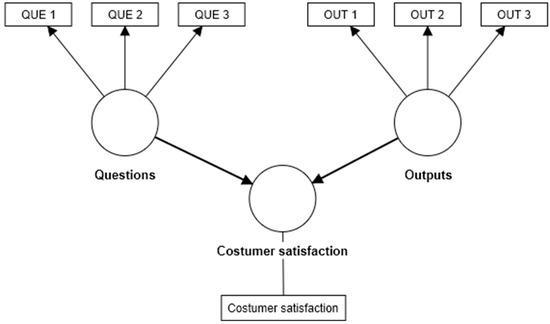
Figure 1.
Theoretical framework of the hypotheses construction. QUE1, technical problems; QUE2, question exhaustiveness; QUE3, questions identification; OUT1, outcomes fulfilment; OUT2, outcomes overlapping; OUT3, product purchasing.
3. Methodology
3.1. AI-Based Advice Structure
The Digital Advice examined is a proprietary product of the considered start-up, MyLab Nutrition Group®; therefore, only the general structure is shown in Figure 2. The algorithm behind the technology is outside the scope of this study.
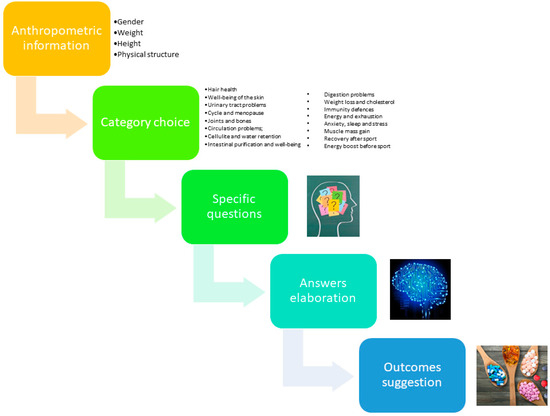
Figure 2.
AI-based advice flow chart.
In the first section, anthropometric information is collected. Then it is possible to choose from one to three of the sixteen available categories, depending on the customer’s specific needs.
Counselling provides specific questions for each category and elaborates on the results. Upon completion, one product for each chosen category is suggested by the AI algorithm.
3.2. Delphi Method
The Delphi process, adjusted to the area of nutrition, was applied in this study. Project RAND developed the Delphi technique in the late 1960s to achieve a consensus from a heterogeneous group of experts [23]. It is a structured multistage process, involving a series of iterative rounds, intended to transform expert opinion into group consensus on a given subject [35]. The Delphi process can be successfully applied to different research areas for determining agreement, and involves a series of questionnaires interspersed with controlled feedback [36]. The group of experts, chosen from the areas of interest, provide their opinions freely, individually, and anonymously; this approach encourages provision of a personal point of view. After each round, a “Panel Coordinator” provides an anonymised summary of experts’ forecasts from the previous round, as well as the reasons they provided for their judgments, encouraging the possibility of revising their earlier answers. It is believed that, during this process, the range of answers will decrease and the group will converge towards the correct answer [37].
In accordance with previous studies [24], the utilised method consisted of three steps:
- Expert recruitment: The expert panel was recruited through public competition. Seven panellists with proven experience (at least three years) in the food and nutrition fields were selected.
- Question evaluation: Each expert was called to indicate any redundant questions—to be omitted—or to add further questions to improve the advice. From the technical assessment, each panellist expressed a score from 1 to 5 (Likert scale) for each question of the advice (Figure 1) [38]. The maximum value of 5 represents an excellent rating in the questionnaire construction; a score of 4, a good structure of the questionnaire; a score of 3 shows gaps in the questions; a score of 2 indicates significant deficiencies in question formulation; and a score of 1 represents a complete lack of prerequisites in the questions.
- Outcome evaluation: To validate the AI-based advice outcomes, the panellists conducted a series of simulations to provide representative cases of reality. In each simulation, the expert impersonated a hypothetic customer to answer the advice questions. A 2 × 2 + 1 scheme was used for this purpose, as reported in Figure 3. The 16 categories were combined, such that each simulation foresaw the coexistence of three categories in the same subject and different clinical problems. The following characteristics were also assigned to complete the simulated consultation: gender, age, constitution (weight and height), presence/absence of pathologies, and allergies/intolerances. The different colours in the table reflect each of the seven panellists to whom the various simulations to be processed were randomly assigned.
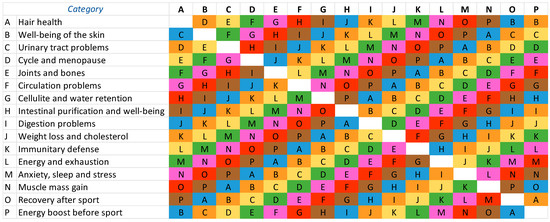 Figure 3. Distribution scheme of category assignment to the experts (each colour corresponds to an expert).
Figure 3. Distribution scheme of category assignment to the experts (each colour corresponds to an expert).
In conclusion, each expert impersonated the different customer prototypes assigned to them (about 35 per panellist) by responding to the advice questionnaire. A score from 1 to 5 was provided for each simulation to evaluate the correspondence between the food supplement the AI recommended and the one the panellist suggested. Additionally, in this case, the Likert scale was used: 5 represents the maximum score and, therefore, total overlap between the supplement recommended by AI and that suggested by the panellist, while 1 states the minimum score, i.e., the complete discordance between the recommended supplements.
3.3. Customer Satisfaction
In order to assess customer satisfaction with the service offered by AI-based advice, a targeted survey was carried out [39]. The survey was administered to company customers. Respondents (n = 178) who declared that they had used AI-based advice were involved in the study. All participants were informed of data anonymity and their use for scientific research purposes. No monetary incentives were provided.
Consistent with the reference literature, a non-probabilistic convenience sampling method was employed, and the threshold of 20:1 respondent/variables ratio was respected [40].
The survey consisted of 16 questions and was structured into three sections. The first part was necessary to conduct a descriptive sample analysis and record general information, such as income, household composition, marital status, etc. (eight socio-demographic attributes). The second part focused on evaluating the advice questions, e.g., exploring the technical problems found, the question exhaustiveness, and the identification in the proposed questions. The third was dedicated to advice outcomes (suggested products) by evaluating the outcome fulfilment and purchasing. The advice outcomes represented the food supplements recommended. The survey also included one control variable, such as the AI-based advice recommendation, used for customer satisfaction evaluation.
The response options were nominal in most cases. Where a rating was required, the Likert scale was used. Partial least square structural equation modelling (PLS-SEM) was used to analyse the data through SmartPLS 4 software [41].
4. Results
The efficiency of the AI-based digital advice, developed by MyLab Nutrition Group® to suggest their food supplements, was evaluated in terms of advice questions and outputs by the Delphi method and customer satisfaction.
4.1. Delphi Method—AI Question Evaluation
The Delphi method was used in this study to evaluate the quality of AI-based advice by a panel of experts in this field [42]. The evaluation process was applied to assess two main areas of AI-based advice, i.e., the questions that advice submitted to customers and the outcomes that the advice suggests.
The results of the evaluation of the questions are summarised in Figure 4. The experts used the Likert scale (ranging from 1 to 5) to evaluate the questions in each category. The average score obtained for the total AI-based advice questions was 4.04 ± 0.51. The lowest score (2.67) was assigned to the category “recovery after sports”, while the highest score (4.67) was assigned to the category “anxiety, sleep and stress”.
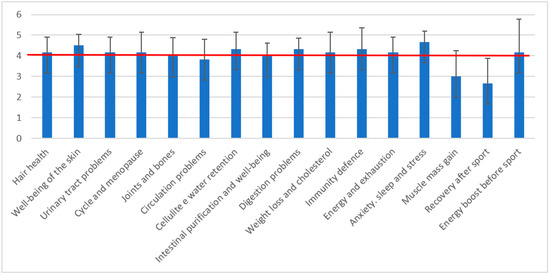
Figure 4.
Evaluation results of the AI-based advice questions by Delphi method.
4.2. Delphi Method—AI Outcomes Evaluation
The second area examined refers to the outcomes of the AI-based advice. Using the Likert scale, experts evaluated the correspondence between the supplement the AI recommended and the one the panellist would have suggested.
Overall, panellists carried out 240 advice simulations in order to provide representative cases of reality. The results of the scores obtained by the AI-based advice are reported in Figure 5. The aggregate analysis of the complete simulations produced an average score of 4.10 ± 0.44. The categories that obtained the highest ex aequo evaluation (4.63) by the panellists were the “digestion problems” and “cycle and menopause” categories; the category that obtained the lowest evaluation was that relating to “recovery after sport” (2.80).
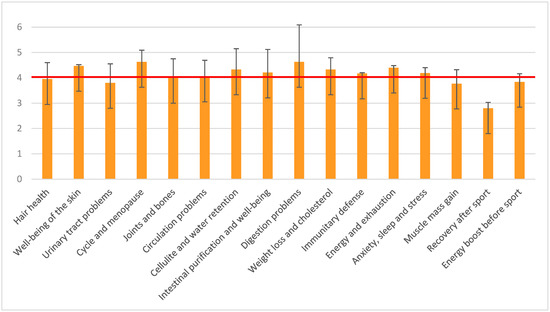
Figure 5.
Evaluation results of the AI-based advice outcomes by Delphi method.
4.3. Comparison of Questions and Outcomes Evaluations
A cartesian visualisation was proposed to compare the results obtained for each category in the question and outcome evaluations (Figure 6). The conceptualisation arose from using the Eco-care Matrix in environmental studies [43,44]. In this case, each category is represented by a point in the diagram in Figure 6. The point coordinates represent the mean scores obtained by each category in question evaluation (x-axis) and outcome evaluation (y-axis). To provide a better visualisation, the scores were scaled to 3 (the minimum score to obtain sufficiency), i.e., each score was subtracted by 3. For example, the digestion problem category obtained 4.33 in question evaluation and 4.63 in outcome evaluation; with the new reference system, these became, respectively, 1.33 and 1.63. Thus, the category position in different quadrants reveals their merit in question and outcome evaluation.
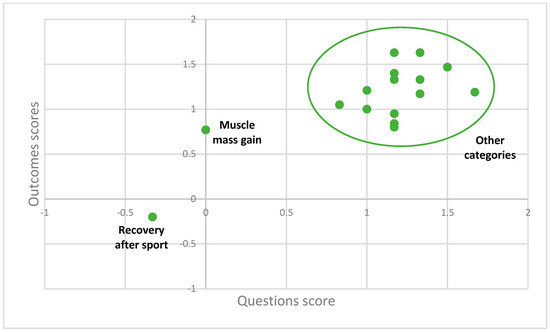
Figure 6.
Comparison between scores in question and outcome evaluations for each category.
4.4. Assessment of Customer Satisfaction
4.4.1. Participant Profiles
The AI-based advice was evaluated from the customers’ point of view by assessing their satisfaction with this service. For this purpose, an ad hoc survey was administered to 178 customers that had used AI-based advice, of which 51.7% were men and 48.3% were women. The age of respondents ranged between 19 and 74. Most respondents (60.1%) had a high school degree, 18.5% had a bachelor’s degree, 11.8% had a middle school degree, and 9.6% had an educational level higher than a bachelor’s degree. The respondents’ households comprised one person for 15.7%, two for 29.8%, three for 26.4% and more than three for 28.1%. Regarding employment, 75.3% of respondents were employed, 19.7% were out of work, and 5% were studying. The household income of most respondents was between EUR 1500 and EUR 3000 per month (55.6%), followed by an income of less than EUR 1500 for 32.6%, and over EUR 3000 for 11.8%. Most respondents were single (52.8%), the remaining sample being married with children (33.7%) or married without children (13.5%). As for housing, 75.8% resided in an urban area, while 24.2% lived in a rural area.
A preliminary descriptive analysis of the results showed a positive attitude of customers toward AI-based advice. Indeed, 88.2% of respondents would recommend AI-based advice. Regarding the variables investigating the AI-based questions, it was found that 96.1% of respondents had not encountered any technical problems, 73% found the questions exhaustive, and 72% could identify themselves in the questions. Therefore, it is possible to estimate the mean satisfaction of the AI-based advice questions for 80.4% of respondents.
Overall, 70% of respondents were satisfied with the outcomes of AI-based advice. In addition, 32% of respondents would not choose the same products without the advice suggestion. Upon requesting a potential purchase of the products recommended through the advice, 71.2% of respondents declared they bought the products or were predisposed to purchase them. So, in this case, it is also possible to estimate the mean satisfaction of AI-based advice outcomes for 69.7% of respondents.
4.4.2. Reliability and Convergent Validity
The internal consistency of the data was examined by Cronbach’s alpha, composite reliability (CR), and average variance extracted (AVE). The results are reported in Table 1. The Cronbach’s alpha values of both constructions were more than 0.80, and CR values were greater than 0.90. These findings indicate the internal consistency of data. The AVE values ranged between 0.636 and 0.875, confirming convergent validity [41]. Figure 7 shows the measurement model that depicts the strength of relationships (path coefficients) among the constructs.

Table 1.
Reliability testing and convergent validity.

Figure 7.
Measurement model.
4.4.3. Descriptive Statistics and Discriminant Validity
A descriptive statistics test was performed to assess mean, median, mode, and standard deviation values, as shown in Table 2. The discriminant validity was determined using the Fornell and Larcker criteria, along with the Heterotrait-Monotrait (HTMT) ratio. As demonstrated in Table 2, the diagonal values were larger than the inter-correlation among the constructs, indicating discriminant validity. Furthermore, the HTMT values of both constructs, reported in Table 3, were lower than 0.90, confirming the discriminant validity [41].

Table 2.
Descriptive statistics and discriminant validity analysis.

Table 3.
Heterotrait-Monotrait ratio (HTMT) results.
4.4.4. Predictive Power of the Inner Model
The predictive power of the inner model was evaluated by coefficient of determination (R2) and cross-validated redundancy (Q2). The value of (R2) of customer satisfaction constructs was 72.4%, explaining a reliable variability. The Q2 was tested through the blindfolding method, and the results were 0% for advice questions and advice outputs, and 2.2% for customer satisfaction, which showed that the model possessed a strong predictive relevance [41].
4.4.5. Hypothesis Testing
The results of the hypotheses testing are presented in Table 4. Hypothesis 1 suggests that the good construction of the questions in the AI-based advice under study positively affects customer satisfaction, which was accepted (β = 0.527, p = 0.000), since the significant value was less than 0.05. Hypothesis 2, proposing that AI-based advice output positively influences customer satisfaction, was also accepted (β = 0.394, p = 0.000). Hence, it can be concluded that all of the proposed hypotheses were accepted. The results of the structural model are shown in Figure 8.

Table 4.
Hypotheses assessment summary.
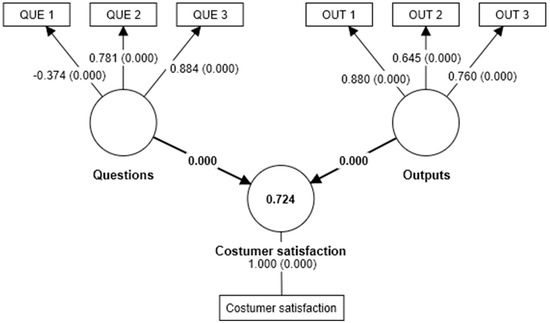
Figure 8.
Structural model.
5. Discussion
5.1. Delphi Method
Regarding the advice questions, the main concerns found by experts were related to the three categories associated with sport. Panellists highlighted an incorrect description of muscle pain in the questions. Specifically, while the advice refers to lactic acid, experts argue that muscle pain in the days following training is due to delayed onset muscle soreness (DOMS). Therefore, it would be appropriate for the company to revise the questions which include this inaccuracy. This feature is also highlighted by the average trend line in Figure 4. Two of the three categories concerning sport, i.e., “muscle mass gain” and “recovery after sports”, had the lowest scores, which were below the adequacy threshold (3.00).
The advice output assessment was positive for almost all the categories. Nevertheless, the experts expressed doubts regarding the categories concerning sport (“muscle mass gain”, “recovery after sport”, and “energy boost before sport”). Indeed, experts would have suggested different products (belonging to the company product catalogue) than those proposed by the advice. For instance, in more than one simulation in which customers’ need regarded post-workout, the advice suggested a pre-workout supplement, even though a specific post-workout supplement was available in the company’s catalogue.
Although the best-formulated questionnaires were those related to “anxiety, sleep and stress”, “skin wellness”, and “cellulite and water retention”, the best output evaluations were those corresponding to “cycle and menopause”, “digestion problems” and “skin wellness”. This mismatch revealed that an excellent formulation of the survey does not always correspond to equal attention to the final product suggested by the AI-based advice.
Regarding the comparison between questions and outputs, as shown in Figure 6, almost all categories were located in the positive–positive quadrant, indicating good results in both evaluations. The “muscle mass gain” category was situated on the y-axis, expressing a barely sufficient assessment in question formulation. The only category out of this quadrant was “recovery after sport”, which was in the negative–negative quadrant, indicating a lack of efficacy of the AI-based advice in this category.
This comparison confirmed the hypothesis of AI-based advice problems in the sports categories.
It should also be noted that, in some cases, panellists would have suggested different supplements in the presence of specific conditions, such as pregnancy, lactation, or hypertension. In fact, in these cases, artificial intelligence recommended formulations containing some ingredients unusual for those conditions, even though no limitation is suggested by a specific regulation (Circular n.3 of 18 July 2002 of the Ministry of Health). However, it should be noted that the simulations were performed by indicating three different health conditions in the same subject. This may have increased the difficulty of the evaluation. Customers usually look for a single need [45], so considering different conditions simultaneously can be viewed as a “stress test” to the advice. This test may have affected the efficiency of the AI-based advice, which usually works with less complex cases.
5.2. Costumer Satisfaction
Relevant conclusions can be drawn from the obtained data. From the point of view of customer satisfaction, AI-based advice is well constructed. In fact, 88.2% of respondents were satisfied with the advice and would recommend it. The consultancy’s strengths are the absence of technical problems during its use, the exhaustiveness of the proposed questions, and the identification in the questions.
Regarding the first hypothesis (H1), dealing with AI-based questions influencing customer satisfaction, the model results, based on the three examined variables, were significant (p-value < 0.001); therefore, the hypothesis is supported. Regarding the effects, the more the respondents identified themselves in the questions, the more they found no technical problems. The more they found the questions exhaustive, the more they were satisfied by the advice. Indeed, the way questions are asked can significantly impact customer satisfaction. Specifically, when customers feel that the questions being asked are tailored to their circumstances and needs, they are more likely to feel satisfied with the advice they receive. This is because personalised questions create a sense of identification with the customer, which can increase their confidence in the advice they receive and enhance their overall satisfaction with the experience. On the other hand, generic or irrelevant questions can create a sense of disconnect and lead to lower levels of customer satisfaction.
Moreover, technical problems during a digital advice session can significantly impact customer satisfaction. When customers seek digital advice, they expect a smooth and seamless experience. Technical issues, such as server errors or software malfunctions, can disrupt the advice flow and cause customer frustration. This can lead to a negative perception of the service, lower levels of trust, and, ultimately, reduced customer satisfaction.
From these results, it is possible to point out that the advice questions fit consumer needs and can be considered positively in this regard. Indeed, a service which adapts its offer to consumer demands has achieved its primary purpose [46].According to the Kano model (1984), customer expectations are based on a two-dimensional system for quality management (expectation vs satisfaction), in which three levels of customer expectation are described: (1) the customer is satisfied that their basic expectations are met, or otherwise are dissatisfied; (2) the customer’s expectations are met depending on the quality/quantity of the performance (or product); (3) the customer’s expectations are met if their unconscious expectations are satisfied, making the customer delighted. In the present work, both the identification and exhaustiveness of AI-based questions had an impact on customer satisfaction, given that 73% of participants found the questions exhaustive, and 72% could identify themselves in the questions, meaning that coherence with subject requirements was respected. It is relevant to highlight that, even though AI technologies have been successfully applied in medicine, pharmacology [47], and clinical pharmacy [48] to promote customer satisfaction, the present work is the first to attempt to combine AI with customer requirements in the food supplements field. To this aim, AI may help analyse customer preferences with a speed and precision not achievable by humans, suggesting that it has the potential to become one of the main tools for enhancing the customer experience.
The second hypothesis (H2) investigated how advice outcomes influence customer satisfaction. Even in this case, the model results were significant (p-value <0.001), and H2 was supported. In this instance, the customer satisfaction variables were the fulfilment of outcomes and product purchasing.
Companies have extensively researched customer satisfaction, since it is a key strategy for gaining competitive advantages [49]. In this context, following the law of supply and demand, a consumer is satisfied if the product has satisfied their request; concurrently, the identification of satisfaction provides a reason to purchase the product. The outcome fulfilment of digital advice can play a crucial role in determining customer satisfaction levels. When customers receive recommendations that meet their needs and expectations, they are more likely to feel satisfied with the advice they receive. In this case study, customer satisfaction with the AI-based advice was also supported by the fact that most respondents later purchased the recommended products. It is probable that the customers were not experts in food supplements, since they were asking for advice, so they had confidence in the service and willingly accepted products that differed from those they had imagined. Different types of consumer behaviour were proposed [50], spanning from “passive” consumers, who did not search for information on alternative products, to “active” consumers, who searched for information at a high level. In our case, consumers had different levels of knowledge about food supplements and brands. These differences in knowledge and experience have significant implications for customers’ information-gathering activities before purchasing [51].
6. Conclusions
A case study of an Italian food supplements start-up which implemented an AI-based advice service to support customers’ choice was analysed in this paper. The aims of the present study were to provide an evaluation of advice outputs performed by experts in food supplements, and to validate and implement the company’s AI-based advice by administering a questionnaire to customers. An innovative integrated evaluation approach, using the Delphi method and customers satisfaction, was applied for this purpose. The results proved an excellent construction of AI-based advice and confirmed the correct recommendation of food supplements.
Regarding customer satisfaction, it was found that the advice questions met customer needs. Importantly, customer satisfaction was also supported by the fact that most respondents purchased the recommended products. The results here showed that AI improves interactive advice, enhancing the costumer experience by offering the best solution to each subject.
It is essential for companies which want to implement AI in their business to invest in robust technology infrastructure and provide technical support to ensure that customers have a positive experience and feel confident in the quality of the digital advice service they receive. Furthermore, stakeholders must focus on delivering accurate and reliable recommendations that will likely result in positive customer outcomes. This can help to build trust and loyalty, leading to increased customer satisfaction and the potential for repeat business.
Great attention should be paid by companies to recommend products that are likely to meet their customer’s needs, as well as ensuring that the purchasing process is straightforward and secure. Doing so can support maximum customer satisfaction levels and create a positive user experience that encourages customers to return for future advice and purchases.
However, the findings of this study must be seen in light of some limitations. For instance, particular attention should be paid to the categories concerning sports. Indeed, experts expressed some doubts regarding the suggested food supplements in these categories. Moreover, the experts noted that the AI-based advice recommended formulations contained some active ingredients not suitable in the presence of specific health conditions (such as pregnancy, lactation, or hypertension). In addition, no evaluations were performed on the algorithms of advice output and customer satisfaction. This implication should be analysed in further studies, as well as an assessment of the advice following the suggested improvements from this study. Overall, this study represents an innovative approach for evaluating digital applications in growing sectors, such as food supplements.
Author Contributions
Conceptualisation, M.R. and S.C.; methodology, M.R., F.O. and S.C.; validation, M.R., V.G. and S.C.; formal analysis, M.R., F.O., M.G.T. and S.C.; investigation, M.R., F.O., M.G.T. and S.C.; data curation, M.R., F.O., M.G.T., V.G. and S.C.; writing—original draft preparation, M.R., V.G. and M.G.T.; writing—review and editing, M.R., V.G., M.G.T., S.C. and M.B.M.; supervision, M.R., V.G. and M.B.M. All authors have read and agreed to the published version of the manuscript.
Funding
This research received no external funding.
Data Availability Statement
Data unavailable due to privacy restrictions.
Acknowledgments
The authors acknowledge My Lab Nutrition Group® for the collaboration to the study.
Conflicts of Interest
The authors declare no conflict of interest.
References
- Hecht, J. Managing Expectations of Artificial Intelligence. Nature 2018, 563, S141–S143. [Google Scholar] [CrossRef] [PubMed]
- Brem, A.; Giones, F.; Werle, M. The AI Digital Revolution in Innovation: A Conceptual Framework of Artificial Intelligence Technologies for the Management of Innovation. IEEE Trans. Eng. Manag. 2023, 70, 770–776. [Google Scholar] [CrossRef]
- Skudalski, L.; Waldman, R.; Kerr, P.E.; Grant-Kels, J.M. Melanoma: How and When to Consider Clinical Diagnostic Technologies. J. Am. Acad. Dermatol. 2022, 86, 503–512. [Google Scholar] [CrossRef] [PubMed]
- Scott, I.A.; Carter, S.M.; Coiera, E. Exploring Stakeholder Attitudes towards AI in Clinical Practice. BMJ Health Care Inform. 2021, 28, e100450. [Google Scholar] [CrossRef]
- Chang, Z.; Zhan, Z.; Zhao, Z.; You, Z.; Liu, Y.; Yan, Z.; Fu, Y.; Liang, W.; Zhao, L. Application of Artificial Intelligence in COVID-19 Medical Area: A Systematic Review. J. Thorac. Dis. 2021, 13, 7034. [Google Scholar] [CrossRef] [PubMed]
- Kim, Y. Precision Nutrition: Approach for Understanding Intra-Individual Biological Variation. J. Nutr. Health 2022, 55, 1–9. [Google Scholar] [CrossRef]
- Tzachor, A.; Devare, M.; King, B.; Avin, S.; Ó hÉigeartaigh, S. Responsible Artificial Intelligence in Agriculture Requires Systemic Understanding of Risks and Externalities. Nat. Mach. Intell. 2022, 4, 104–109. [Google Scholar] [CrossRef]
- Car, N.J. USING Decision Models to Enable Better Irrigation Decision Support Systems. Comput. Electron. Agric. 2018, 152, 290–301. [Google Scholar] [CrossRef]
- Tripodi, P.; Nicastro, N.; Pane, C. Digital Applications and Artificial Intelligence in Agriculture toward Next-Generation Plant Phenotyping. Crop Pasture Sci. 2022, 74. [Google Scholar] [CrossRef]
- Ibn-Mohammed, T. Application of Mixed-Mode Research Paradigms to the Building Sector: A Review and Case Study towards Decarbonising the Built and Natural Environment. Sustain. Cities Soc. 2017, 35, 692–714. [Google Scholar] [CrossRef]
- Debrah, C.; Chan, A.P.C.; Darko, A. Artificial Intelligence in Green Building. Autom. Constr. 2022, 137, 104192. [Google Scholar] [CrossRef]
- Gruyer, D.; Magnier, V.; Hamdi, K.; Claussmann, L.; Orfila, O.; Rakotonirainy, A. Perception, Information Processing and Modeling: Critical Stages for Autonomous Driving Applications. Annu. Rev. Control 2017, 44, 323–341. [Google Scholar] [CrossRef]
- Ahmad, T.; Zhu, H.; Zhang, D.; Tariq, R.; Bassam, A.; Ullah, F.; AlGhamdi, A.S.; Alshamrani, S.S. Energetics Systems and Artificial Intelligence: Applications of Industry 4.0. Energy Rep. 2022, 8, 334–361. [Google Scholar] [CrossRef]
- Venkatasubramanian, V.; Mann, V. Artificial Intelligence in Reaction Prediction and Chemical Synthesis. Curr. Opin. Chem. Eng. 2022, 36, 100749. [Google Scholar] [CrossRef]
- Baghbani, A.; Choudhury, T.; Costa, S.; Reiner, J. Application of Artificial Intelligence in Geotechnical Engineering: A State-of-the-Art Review. Earth Sci. Rev. 2022, 228, 103991. [Google Scholar] [CrossRef]
- Chen, L.; Jiang, M.; Jia, F.; Liu, G. Artificial Intelligence Adoption in Business-to-Business Marketing: Toward a Conceptual Framework. J. Bus. Ind. Mark. 2022, 37, 1025–1044. [Google Scholar] [CrossRef]
- Gomes, P.; Verçosa, L.; Melo, F.; Silva, V.; Filho, C.B.; Bezerra, B. Artificial Intelligence-Based Methods for Business Processes: A Systematic Literature Review. Appl. Sci. 2022, 12, 2314. [Google Scholar] [CrossRef]
- Ahmad, S.F.; Alam, M.M.; Rahmat, M.K.; Mubarik, M.S.; Hyder, S.I. Academic and Administrative Role of Artificial Intelligence in Education. Sustainability 2022, 14, 1101. [Google Scholar] [CrossRef]
- Bao, J.; Xie, Q. Artificial Intelligence in Animal Farming: A Systematic Literature Review. J. Clean. Prod. 2022, 331, 129956. [Google Scholar] [CrossRef]
- Goel, P.; Kaushik, N.; Sivathanu, B.; Pillai, R.; Vikas, J. Consumers’ Adoption of Artificial Intelligence and Robotics in Hospitality and Tourism Sector: Literature Review and Future Research Agenda. Tour. Rev. 2022, 77, 1081–1096. [Google Scholar] [CrossRef]
- Köchling, A.; Wehner, M.C.; Warkocz, J. Can I Show My Skills? Affective Responses to Artificial Intelligence in the Recruitment Process. Rev. Manag. Sci. 2022. [Google Scholar] [CrossRef]
- Magistretti, S.; Dell’Era, C.; Messeni Petruzzelli, A. How Intelligent Is Watson? Enabling Digital Transformation through Artificial Intelligence. Bus. Horiz. 2019, 62, 819–829. [Google Scholar] [CrossRef]
- Baran, P. On Distributed Communications: I. Introduction to Distributed Communications Networks; RAND Corporation: Santa Monica, CA, USA, 2018. [Google Scholar]
- Bellizzi, V.; Bianchi, S.; Bolasco, P.; Brunori, G.; Cupisti, A.; Gambaro, G.; Gesualdo, L.; Polito, P.; Santoro, D.; Santoro, A. A Delphi Consensus Panel on Nutritional Therapy in Chronic Kidney Disease. J. Nephrol. 2016, 29, 593–602. [Google Scholar] [CrossRef]
- Blumberg, J.B.; Cena, H.; Barr, S.I.; Biesalski, H.K.; Dagach, R.U.; Delaney, B.; Frei, B.; Moreno González, M.I.; Hwalla, N.; Lategan-Potgieter, R.; et al. The Use of Multivitamin/Multimineral Supplements: A Modified Delphi Consensus Panel Report. Clin. Ther. 2018, 40, 640–657. [Google Scholar] [CrossRef] [PubMed]
- Brown, M.; Pope, N.; Voges, K. Buying or Browsing? Eur. J. Mark. 2003, 37, 1666–1684. [Google Scholar] [CrossRef]
- Cueva, A.; Akhmedova, A.; Marimon, F. Effect of covid on the sharing economy: Delphi analysis confirms that quality plays a key role in customers’ satisfaction. Int. J. Qual. Res. 2023, 17, 209–226. [Google Scholar] [CrossRef]
- Rahmani, M.; Sohrabi, R.; Zandi, P. Identifying the Factors Affecting the Customer Satisfaction of Food Industries Using Thematic Analysis and Delphi. J. Econ. Adm. Sci. 2022, 5, 467–482. [Google Scholar]
- Adak, A.; Pradhan, B.; Shukla, N. Sentiment Analysis of Customer Reviews of Food Delivery Services Using Deep Learning and Explainable Artificial Intelligence: Systematic Review. Foods 2022, 11, 1500. [Google Scholar] [CrossRef]
- Brock, J.K.U.; von Wangenheim, F. Demystifying Ai: What Digital Transformation Leaders Can Teach You about Realistic Artificial Intelligence. Calif. Manag. Rev. 2019, 61, 110–134. [Google Scholar] [CrossRef]
- Mende, M.; Scott, M.L.; van Doorn, J.; Grewal, D.; Shanks, I. Service Robots Rising: How Humanoid Robots Influence Service Experiences and Elicit Compensatory Consumer Responses. J. Mark. Res. 2019, 56, 535–556. [Google Scholar] [CrossRef]
- Merkle, M. Customer Responses to Service Robots Comparing Human-Robot Interaction with Human-Human Interaction. In Proceedings of the 52nd Annual Hawaii International Conference on System Sciences, Maui, HI, USA, 8–11 January 2019. [Google Scholar]
- Giroux, M.; Kim, J.; Lee, J.C.; Park, J. Artificial Intelligence and Declined Guilt: Retailing Morality Comparison Between Human and AI. J. Bus. Ethics 2022, 178, 1027–1041. [Google Scholar] [CrossRef] [PubMed]
- Weun, S.; Beatty, S.; Jones, M. The Impact of Service Failure Severity on Service Recovery Evaluations and Post-Recovery Relationships The Impact of Service Failure Severity on Service Recovery Evaluations and Post-Recovery Relationships. J. Serv. Mark. 2004, 18, 133–146. [Google Scholar] [CrossRef]
- Hasson, F.; Keeney, S.; McKenna, H. Research Guidelines for the Delphi Survey Technique. J. Adv. Nurs. 2000, 32, 1008–1015. [Google Scholar] [CrossRef]
- Lynn, M.R.; Layman, E.L.; Englebardt, S.P. Nursing Administration Research Priorities: A National Delphi Study. J. Nurs. Adm. 1998, 28, 7–11. [Google Scholar] [CrossRef] [PubMed]
- Rowe, G.; Wright, G. The Delphi Technique as a Forecasting Tool: Issues and Analysis. Int. J. Forecast. 1999, 15, 353–375. [Google Scholar] [CrossRef]
- Cheng, C.; Lay, K.L.; Hsu, Y.F.; Tsai, Y.M. Can Likert Scales Predict Choices? Testing the Congruence between Using Likert Scale and Comparative Judgment on Measuring Attribution. Methods Psychol. 2021, 5, 100081. [Google Scholar] [CrossRef]
- Reichheld, F.F. The One Number You Need to Grow. Harv. Bus. Rev. 2003, 81, 46–55. [Google Scholar]
- Wang, O.; Somogyi, S. Motives for Luxury Seafood Consumption in First-Tier Cities in China. Food Qual. Prefer. 2020, 79, 103780. [Google Scholar] [CrossRef]
- Waris, I.; Ali, R.; Nayyar, A.; Baz, M.; Liu, R.; Hameed, I. An Empirical Evaluation of Customers’ Adoption of Drone Food Delivery Services: An Extended Technology Acceptance Model. Sustainability 2022, 14, 2922. [Google Scholar] [CrossRef]
- Salsas, J.G.; Saurí, S.; Raventós, E.; Rúa, C.; Torrent, J. Emerging Trends Defining the Future Role of Ports: Application of the Delphi Method. Transp. Res. Rec. 2022, 2676, 571–585. [Google Scholar] [CrossRef]
- Auer, J.; Bey, N.; Schäfer, J.M. Combined Life Cycle Assessment and Life Cycle Costing in the Eco-Care-Matrix: A Case Study on the Performance of a Modernized Manufacturing System for Glass Containers. J. Clean. Prod. 2017, 141, 99–109. [Google Scholar] [CrossRef]
- Vinci, G.; D’Ascenzo, F.; Esposito, A.; Musarra, M.; Rapa, M.; Rocchi, A. A Sustainable Innovation in the Italian Glass Production: LCA and Eco-Care Matrix Evaluation. J. Clean. Prod. 2019, 223, 587–595. [Google Scholar] [CrossRef]
- Placentino, U.; Sogari, G.; Viscecchia, R.; de Devitiis, B.; Monacis, L. The New Challenge of Sports Nutrition: Accepting Insect Food as Dietary Supplements in Professional Athletes. Foods 2021, 10, 1117. [Google Scholar] [CrossRef] [PubMed]
- Aydınocak, E.U. Internet of Things (IoT) in Marketing Logistics. In Accounting, Finance, Sustainability, Governance and Fraud; Springer: Singapore, 2022. [Google Scholar]
- Esfandiari, N.; Reza, M.; Moghadam, A.E. Expert Systems with Applications Knowledge Discovery in Medicine: Current Issue and Future Trend. Expert Syst. Appl. 2014, 41, 4434–4463. [Google Scholar] [CrossRef]
- Čufar, A.; Mrhar, A.; Robnik-Šikonja, M. Assessment of Surveys for the Management of Hospital Clinical Pharmacy Services. Artif. Intell. Med. 2015, 64, 147–158. [Google Scholar] [CrossRef]
- Juanamasta, I.G.; Wati, N.M.N.; Hendrawati, E.; Wahyuni, W.; Pramudianti, M.; Wisnujati, N.S.; Setiawati, A.P.; Susetyorini, S.; Elan, U.; Rusdiyanto, R.; et al. The Role of Customer Service through Customer Relationship Management (Crm) to Increase Customer Loyalty and Good Image. Int. J. Sci. Technol. Res. 2019, 8, 2004–2007. [Google Scholar]
- Beckett, A.; Hewer, P.; Howcroft, B. An Exposition of Consumer Behaviour in the Financial Services Industry. Int. J. Bank Mark. 2000, 18, 15–26. [Google Scholar] [CrossRef]
- Durso, F.T.; Nickerson, R.S.; Dumais, S.T.; Lewandowsky, S.; Perfect, T.J. Handbook of Applied Cognition, 2nd ed.; John Wiley & Sons: Hoboken, NJ, USA, 2008. [Google Scholar]
Disclaimer/Publisher’s Note: The statements, opinions and data contained in all publications are solely those of the individual author(s) and contributor(s) and not of MDPI and/or the editor(s). MDPI and/or the editor(s) disclaim responsibility for any injury to people or property resulting from any ideas, methods, instructions or products referred to in the content. |
© 2023 by the authors. Licensee MDPI, Basel, Switzerland. This article is an open access article distributed under the terms and conditions of the Creative Commons Attribution (CC BY) license (https://creativecommons.org/licenses/by/4.0/).